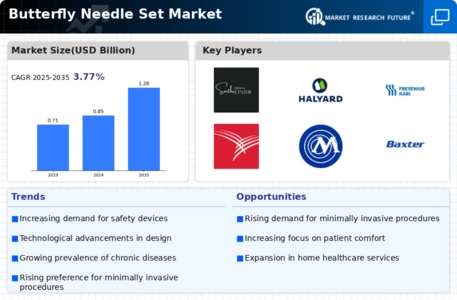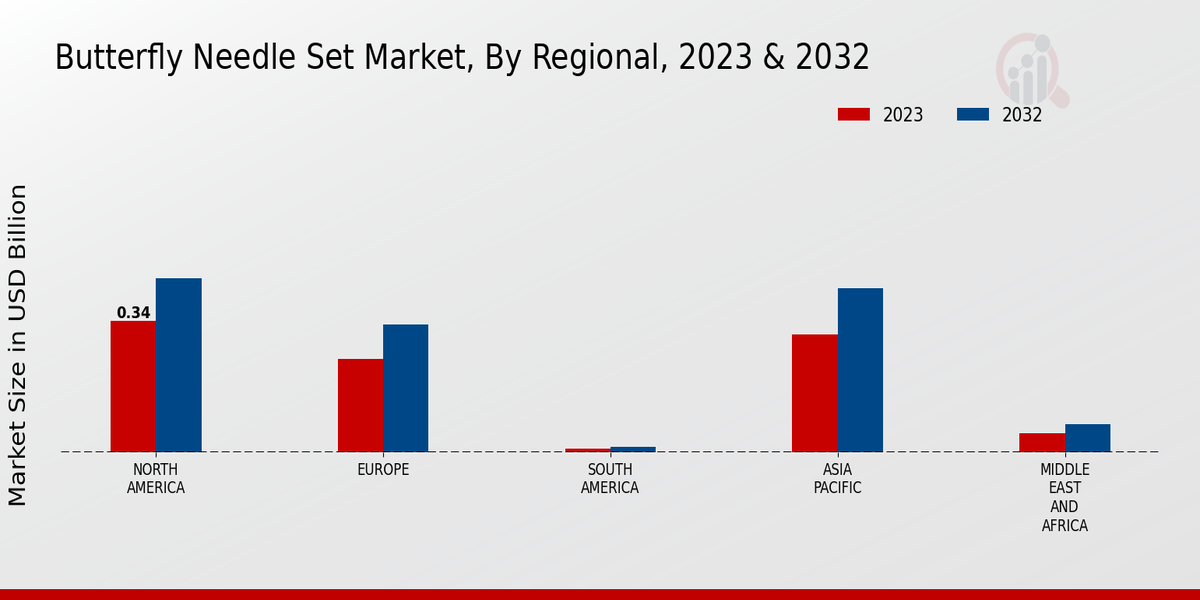Market Growth Projections
The Global Butterfly Needle Set Market Industry is projected to experience substantial growth over the next decade. With a market value of 0.85 USD Billion in 2024, it is anticipated to reach 1.28 USD Billion by 2035. This growth trajectory indicates a compound annual growth rate of 3.76% from 2025 to 2035. Factors contributing to this expansion include technological advancements, increasing demand for minimally invasive procedures, and a growing focus on patient safety. The market's evolution reflects broader trends in healthcare, where the emphasis on efficiency and quality of care continues to shape the development and adoption of medical devices.
Growing Awareness of Patient Safety
The Global Butterfly Needle Set Market Industry is experiencing growth fueled by heightened awareness of patient safety among healthcare professionals and institutions. The emphasis on reducing complications associated with venipuncture, such as infections and hematomas, has led to increased adoption of butterfly needles, which are designed to minimize these risks. Educational initiatives and training programs are being implemented to inform healthcare workers about the benefits of using butterfly needles. This focus on safety not only enhances patient outcomes but also aligns with broader healthcare goals of improving quality of care. As awareness continues to rise, the market is expected to expand in response to these evolving standards.
Increasing Prevalence of Chronic Diseases
The Global Butterfly Needle Set Market Industry is significantly impacted by the rising prevalence of chronic diseases such as diabetes and cardiovascular disorders. These conditions often require frequent blood sampling and intravenous access, leading to a higher demand for butterfly needles. Healthcare systems are adapting to this growing need by incorporating butterfly needle sets into their standard procedures. This trend is further supported by demographic shifts, including an aging population that necessitates more frequent medical interventions. Consequently, the market is poised for steady growth, with a compound annual growth rate of 3.76% anticipated from 2025 to 2035, reflecting the ongoing need for effective medical tools.
Technological Advancements in Needle Design
Innovations in needle design significantly influence the Global Butterfly Needle Set Market Industry. Manufacturers are investing in research and development to create needles that offer improved ergonomics, enhanced safety features, and better fluid flow rates. For instance, the introduction of safety-engineered butterfly needles aims to reduce the risk of needlestick injuries, which is a critical concern in healthcare settings. These advancements not only improve the user experience for healthcare professionals but also contribute to patient safety. As the market evolves, these technological enhancements are expected to drive growth, with projections indicating a market value of 1.28 USD Billion by 2035.
Regulatory Support for Advanced Medical Devices
Regulatory bodies play a crucial role in shaping the Global Butterfly Needle Set Market Industry by establishing guidelines that promote the use of advanced medical devices. Governments are increasingly recognizing the importance of safety and efficacy in medical tools, leading to streamlined approval processes for innovative butterfly needle designs. This regulatory support not only encourages manufacturers to invest in new technologies but also enhances market confidence among healthcare providers. As a result, the industry is likely to witness an influx of new products that meet stringent safety standards, further driving market growth. The alignment of regulatory frameworks with industry needs fosters a conducive environment for sustained expansion.
Rising Demand for Minimally Invasive Procedures
The Global Butterfly Needle Set Market Industry experiences a notable increase in demand driven by the growing preference for minimally invasive procedures. Healthcare providers are increasingly adopting butterfly needles due to their ability to facilitate easier access to veins, reducing patient discomfort and recovery time. This trend is particularly evident in outpatient settings, where efficiency and patient satisfaction are paramount. As a result, the market is projected to reach 0.85 USD Billion in 2024, reflecting the industry's responsiveness to evolving medical practices. The shift towards minimally invasive techniques is likely to sustain growth, as it aligns with broader healthcare objectives of enhancing patient care.








